How to Translate English for Science and Technology(EST) Materials
- 格式:doc
- 大小:67.50 KB
- 文档页数:16
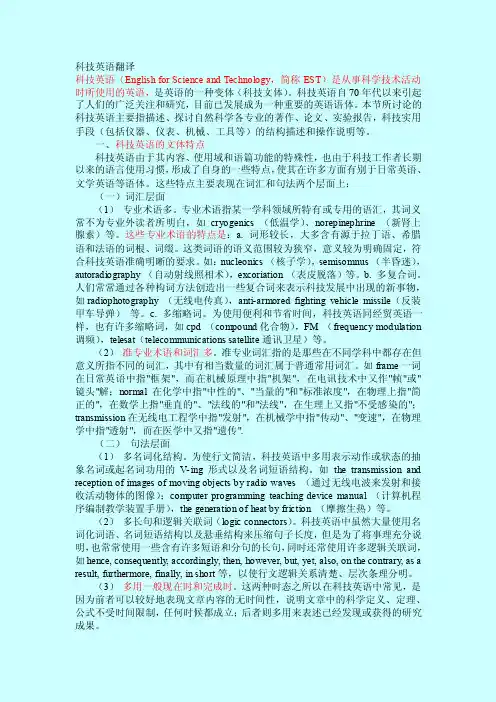
科技英语翻译科技英语(English for Science and Technology,简称EST)是从事科学技术活动时所使用的英语,是英语的一种变体(科技文体)。
科技英语自70年代以来引起了人们的广泛关注和研究,目前已发展成为一种重要的英语语体。
本节所讨论的科技英语主要指描述、探讨自然科学各专业的著作、论文、实验报告,科技实用手段(包括仪器、仪表、机械、工具等)的结构描述和操作说明等。
一、科技英语的文体特点科技英语由于其内容、使用域和语篇功能的特殊性,也由于科技工作者长期以来的语言使用习惯,形成了自身的一些特点,使其在许多方面有别于日常英语、文学英语等语体。
这些特点主要表现在词汇和句法两个层面上:(一)词汇层面(1)专业术语多。
专业术语指某一学科领域所特有或专用的语汇,其词义常不为专业外读者所明白,如cryogenics (低温学)、norepinephrine (新肾上腺素)等。
这些专业术语的特点是:a. 词形较长,大多含有源于拉丁语、希腊语和法语的词根、词缀。
这类词语的语义范围较为狭窄,意义较为明确固定,符合科技英语准确明晰的要求。
如:nucleonics (核子学),semisomnus (半昏迷),autoradiography (自动射线照相术),excoriation (表皮脱落)等。
b. 多复合词。
人们常常通过各种构词方法创造出一些复合词来表示科技发展中出现的新事物,如radiophotography (无线电传真),anti-armored fighting vehicle missile(反装甲车导弹)等。
c. 多缩略词。
为使用便利和节省时间,科技英语同经贸英语一样,也有许多缩略词,如cpd (compound化合物),FM (frequency modulation 调频),telesat(telecommunications satellite通讯卫星)等。
(2)准专业术语和词汇多。
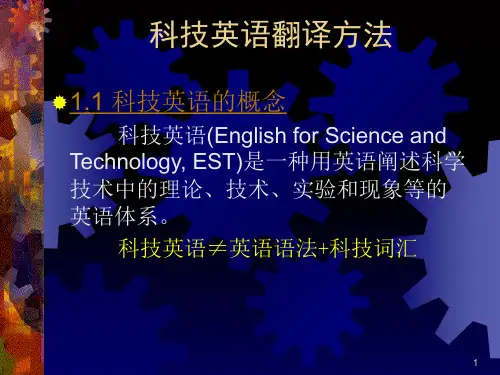
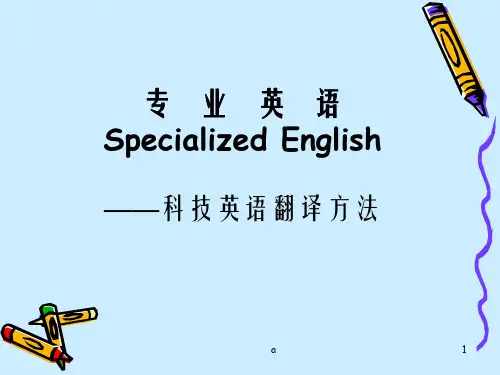
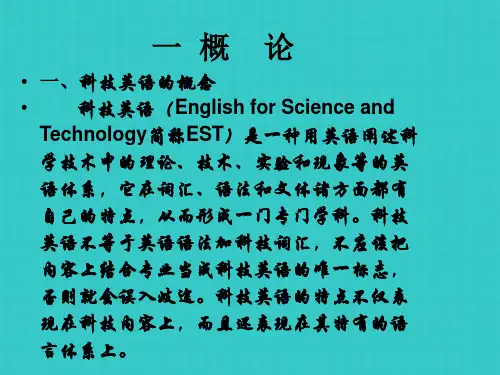
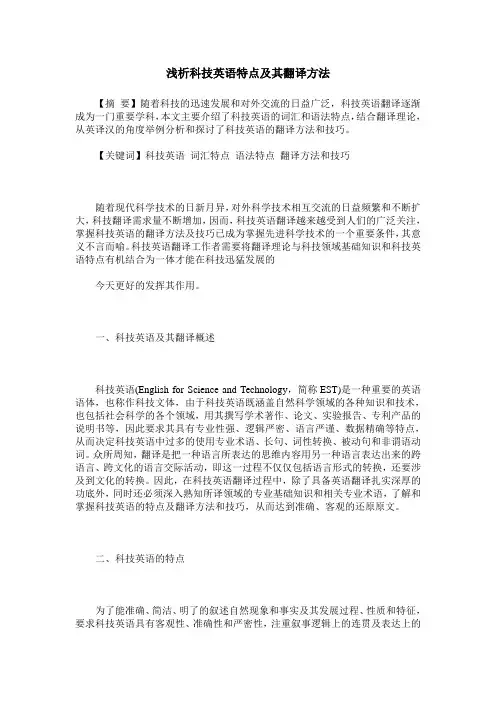
浅析科技英语特点及其翻译方法【摘要】随着科技的迅速发展和对外交流的日益广泛,科技英语翻译逐渐成为一门重要学科,本文主要介绍了科技英语的词汇和语法特点,结合翻译理论,从英译汉的角度举例分析和探讨了科技英语的翻译方法和技巧。
【关键词】科技英语词汇特点语法特点翻译方法和技巧随着现代科学技术的日新月异,对外科学技术相互交流的日益频繁和不断扩大,科技翻译需求量不断增加,因而,科技英语翻译越来越受到人们的广泛关注,掌握科技英语的翻译方法及技巧已成为掌握先进科学技术的一个重要条件,其意义不言而喻。
科技英语翻译工作者需要将翻译理论与科技领域基础知识和科技英语特点有机结合为一体才能在科技迅猛发展的今天更好的发挥其作用。
一、科技英语及其翻译概述科技英语(English for Science and Technology,简称EST)是一种重要的英语语体,也称作科技文体,由于科技英语既涵盖自然科学领域的各种知识和技术,也包括社会科学的各个领域,用其撰写学术著作、论文、实验报告、专利产品的说明书等,因此要求其具有专业性强、逻辑严密、语言严谨、数据精确等特点,从而决定科技英语中过多的使用专业术语、长句、词性转换、被动句和非谓语动词。
众所周知,翻译是把一种语言所表达的思维内容用另一种语言表达出来的跨语言、跨文化的语言交际活动,即这一过程不仅仅包括语言形式的转换,还要涉及到文化的转换。
因此,在科技英语翻译过程中,除了具备英语翻译扎实深厚的功底外,同时还必须深入熟知所译领域的专业基础知识和相关专业术语,了解和掌握科技英语的特点及翻译方法和技巧,从而达到准确、客观的还原原文。
二、科技英语的特点为了能准确、简洁、明了的叙述自然现象和事实及其发展过程、性质和特征,要求科技英语具有客观性、准确性和严密性,注重叙事逻辑上的连贯及表达上的明晰与畅达,避免行文晦涩。
科技英语力求平易和精确,避免使用旨在加强语言感染力和宣传效果的各种修辞格,以免使读者产生行文浮华、内容虚饰之感。
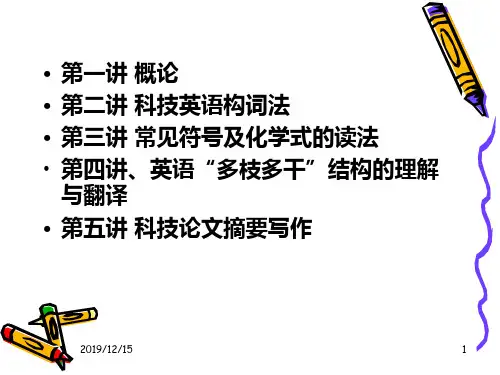
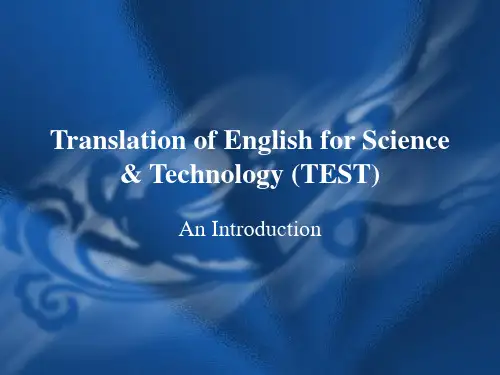
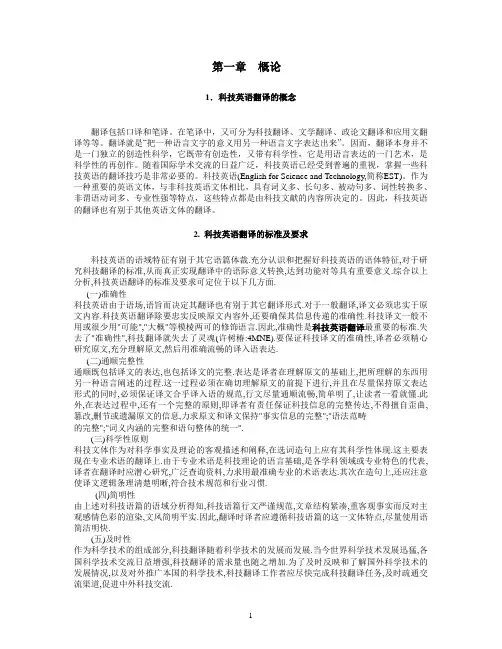
1 第一章 概论 1.科技英语翻译的概念 翻译包括口译和笔译。在笔译中,又可分为科技翻译、文学翻译、政论文翻译和应用文翻译等等。翻译就是―把一种语言文字的意义用另一种语言文字表达出来‖。因而,翻译本身并不是一门独立的创造性科学,它既带有创造性,又带有科学性,它是用语言表达的一门艺术,是科学性的再创作。随着国际学术交流的日益广泛,科技英语已经受到普遍的重视,掌握一些科技英语的翻译技巧是非常必要的。科技英语(English for Science and Technology,简称EST)。作为一种重要的英语文体,与非科技英语文体相比,具有词义多、长句多、被动句多、词性转换多、非谓语动词多、专业性强等特点,这些特点都是由科技文献的内容所决定的。因此,科技英语的翻译也有别于其他英语文体的翻译。
2. 科技英语翻译的标准及要求 科技英语的语域特征有别于其它语篇体裁.充分认识和把握好科技英语的语体特征,对于研究科技翻译的标准,从而真正实现翻译中的语际意义转换,达到功能对等具有重要意义.综合以上分析,科技英语翻译的标准及要求可定位于以下几方面. (一)准确性 科技英语由于语场,语旨而决定其翻译也有别于其它翻译形式.对于一般翻译,译文必须忠实于原文内容.科技英语翻译除要忠实反映原文内容外,还要确保其信息传递的准确性.科技译文一般不用或很少用"可能","大概"等模棱两可的修饰语言.因此,准确性是科技英语翻译最重要的标准.失去了"准确性",科技翻译就失去了灵魂(许树椿:4MNE).要保证科技译文的准确性,译者必须精心研究原文,充分理解原文,然后用准确流畅的译入语表达. (二)通顺完整性 通顺既包括译文的表达,也包括译文的完整.表达是译者在理解原文的基础上,把所理解的东西用另一种语言阐述的过程.这一过程必须在确切理解原文的前提下进行,并且在尽量保持原文表达形式的同时,必须保证译文合乎译入语的规范,行文尽量通顺流畅,简单明了,让读者一看就懂.此外,在表达过程中,还有一个完整的原则,即译者有责任保证科技信息的完整传达,不得擅自歪曲,篡改,删节或遗漏原文的信息,力求原文和译文保持"事实信息的完整";"语法范畴 的完整";"词义内涵的完整和语句整体的统一". (三)科学性原则 科技文体作为对科学事实及理论的客观描述和阐释,在选词造句上应有其科学性体现.这主要表现在专业术语的翻译上.由于专业术语是科技理论的语言基础,是各学科领域或专业特色的代表,译者在翻译时应潜心研究,广泛查询资料,力求用最准确专业的术语表达.其次在造句上,还应注意使译文逻辑条理清楚明晰,符合技术规范和行业习惯. (四)简明性 由上述对科技语篇的语域分析得知,科技语篇行文严谨规范,文章结构紧凑,重客观事实而反对主观感情色彩的渲染,文风简明平实.因此,翻译时译者应遵循科技语篇的这一文体特点,尽量使用语简洁明快. (五)及时性 作为科学技术的组成部分,科技翻译随着科学技术的发展而发展.当今世界科学技术发展迅猛,各国科学技术交流日益增强,科技翻译的需求量也随之增加.为了及时反映和了解国外科学技术的发展情况,以及对外推广本国的科学技术,科技翻译工作者应尽快完成科技翻译任务,及时疏通交流渠道,促进中外科技交流. 2
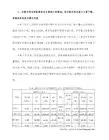
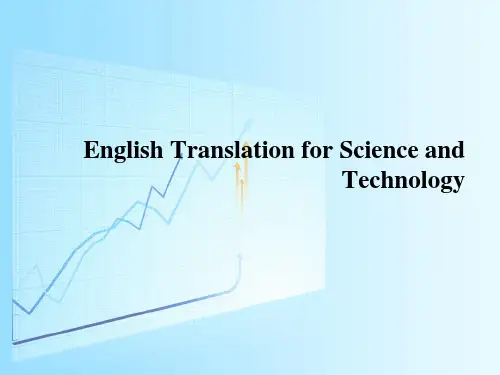
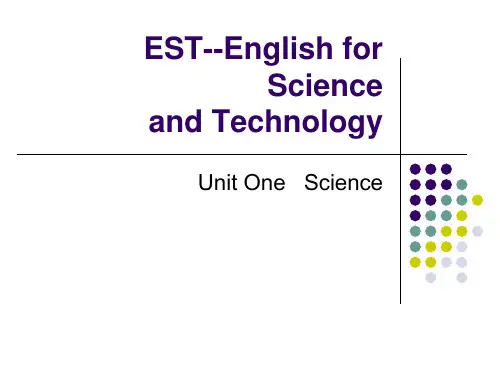
How to Translate English for Science and Technology(EST) Materials Contents
I. Brief introduction of EST translation
II. Features of EST in Vocabulary, Sentence, and Grammer and the specific translating methods
III. The conclusion I.Brief introduction of EST translation 1.1 what is translation Translation,essentially,is the faithful representation,in on language,of what is written or said in another language.(摘自钟述孔著,英汉翻译手册(增订版)) 1.2. Principles of Translation The main principles of translation are faithfulness, expressiveness and elegance which were first proposed by Yan Fu. The English for Science and Technology (EST) emphasizes particularly the principles of faithfulness and elegance. 1.3. The Characteristics of EST Translation 1.3.1The principle of EST Translation: The translation target of EST is scientific documents. The scientific materials are characterized by preciseness. So EST translation is marked by objectivity, standardization, distinctive feature in literary form, regular syntax. Objectivity means that the translator cannot change the original ideas, neglect the information or put own comments in the process of translation. He must translate the original into Chinese version accurately. standardization means that we should always use some professional expressions like technical terms. As we know, newly created technical terms are pouring into English for science and technology. The accumulation of new words is quite important. The characteristics of EST will be discussed in following chapters. 1.3.2 The Characteristic Vocabulary of EST: The most remarkable characteristic of EST is extensive use of technical terms. A great number of them come from the words used commonly in our daily life. But they have strict technical meaning in EST. EST borrows words in common use to explain the professional technical concepts.So during the translation we must pay attention to those common words. 1.4 The requirements for EST translator 1.4.1 lingustic prficiency: the translator must be good at both the English and Chinese. To cite a saying ― A good translator reads a foreign language but thinks in his own.‖ We have to bear always in mind that Chinese and English are two entirely diffenent languages, each having its own usage and idiom, its own grammar and stylistic devices,own cultural and social background. 1.4.2 encyclopedic knowledge: we all know that EST is different from generaly English for it has lots of technical terms, and relates to science and technology which is not familiar to us.Only when we have encyclopedic knowledge, can we fully understand the original material. 1.4.3 Having a konwledge about the features of EST Science material unlike essay ,narration,or any other kind of style has its own features, which we must bear in mind. Having a grasp of the features of EST will do good to EST translation. II.Features of EST in Vocabulary,Sentence,and Grammer The general features of EST is objective,accuracy,conciseness.In order to achieve such kind of features, there are some special devices such as general use of nominalization ,extensive use of the passive voice ,long and complicated sentences ,as well as more non-finite forms of verbs ,that we al should pay special attention during our translation. 2.1 Features of EST in Vocabulary, 2.1.1 As we have talked before some features of vocabulary before, now let us talk about the specific translation methods of EST vocabularies. Generally, there are two methods in the translation of EST vocabularies: literal translation and free translation. The literal translation includes transplant, transliteration and pictographic translation, etc. The free translation includes deduction, extension and explanation, etc. 2.1.2 General Use of Nominalization Another striking feature of EST vocabulary is the gereral use of nominalation. Then, what is nominalizationn? In linguistics, nominalization is the use of a verb or an adjective as a noun, with or without morphological transformation, so that the word can now act as the head of a noun phrase. As we all know,English is static, and nouns are frequently used to replace verbs, while Chinese is dynamic, using more verbs in a single sentence. Compared with general English, noun phrases are more frequently used in EST. This is because scientific literature contains more abstract concepts such as definitions, principles, laws, conclusions, etc., and manifold modification and restriction are required to elaborate these concepts or ideas. As the semantic meaning of a noun phrase that consists of several words is usually complicated, the translation should go beyond the surface structure. There is a variety of nominalization ,for example: a. Lexical nominalization For example: 计算机在数据和信息处理中的应用 PC applications in data and information processing 声音识别设备 voice recognition equipment b. Expanded Noun Premodifiers 水 泵 阀 例:water pump valve